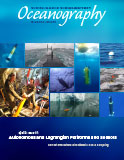Chao, Y., J.D. Farrara, H. Zhang, K.J. Armenta, L. Centurioni, F. Chavez, J.B. Girton, D. Rudnick, and R.K. Walker. 2017. Development, implementation, and validation of a California coastal ocean modeling, data assimilating and forecasting system. Deep Sea Research Part II, https://doi.org/10.1016/j.dsr2.2017.04.013.
Cole, S.T., and D.L. Rudnick. 2012. The spatial distribution and annual cycle of upper ocean thermohaline structure. Journal of Geophysical Research 117, C02027, https://doi.org/10.1029/2011JC007033.
Curtin, T.B., and J.G. Bellingham. 2009. Progress toward autonomous ocean sampling networks. Deep Sea Research Part II 56:62–67, https://doi.org/10.1016/j.dsr2.2008.09.005.
Curtin, T.B., J.G. Bellingham, J. Catipovic, and D. Webb. 1993. Autonomous oceanographic sampling networks. Oceanography 6(3):86–94, https://doi.org/10.5670/oceanog.1993.03.
Das, J., F. Py, T. Maughan, T. O’Reilly, M. Messie, J. Ryan, K. Rajan, and G. Sukhatme. 2014. Simultaneous tracking and sampling of dynamic oceanographic features with autonomous underwater vehicles and Lagrangian drifters. Pp. 541–555 in Experimental Robotics. Springer.
Egbert, G.D., A.F. Bennett, and M.G.G. Foreman. 1994. TOPEX/POSEIDON tides estimated using a global inverse model. Journal of Geophysical Research 99:24,821–24,852, https://doi.org/10.1029/94JC01894.
Egbert, G.D., and S.Y. Erofeeva. 2002. Efficient inverse modeling of barotropic ocean tides. Journal of Atmospheric and Oceanic Technology 19:183–204, https://doi.org/10.1175/1520-0426(2002)019<0183:EIMOBO>2.0.CO;2.
Flament, P. 1986. Finestructure and Subduction Associated with Upwelling Filaments. PhD Thesis, University of California, San Diego.
Flament, P. 2002. A state variable for characterizing water masses and their diffusive stability: Spiciness. Progress in Oceanography 54:493–501, https://doi.org/10.1016/S0079-6611(02)00065-4.
Flexas, M.M., M.I. Troesch, S. Chu, A. Branch, S. Chien, A.F. Thompson, J. Farrara, and Y. Chao. In press. Autonomous sampling of ocean submesoscale fronts with ocean gliders and numerical forecasting. Journal of Atmospheric and Oceanic Technology.
Leonard, N.E., D.A. Paley, R.E. Davis, D.M. Fratantoni, F. Lekien, and F. Zhang. 2010. Coordinated control of an underwater glider fleet in an adaptive ocean sampling field experiment in Monterey Bay. Journal of Field Robotics 27:718–740, https://doi.org/10.1002/rob.20366.
LeTraon, P.Y. 2013. From satellite altimetry to Argo and operational oceanography: Three revolutions in oceanography. Ocean Science 9:901–915, https://doi.org/10.5194/os-9-901-2013.
Lévy, M., L. Bopp, P. Karleskind, L. Resplandy, C. Ethe, and F. Pinsard. 2013. Physical pathways for carbon transfers between the surface mixed layer and the ocean interior. Global Biogeochemical Cycles 27:1,001–1,012, https://doi.org/10.1002/gbc.20092.
Lévy, M., R. Ferrari, P.J.S. Franks, A.P. Martin, and P. Rivière. 2012. Bringing physics to life at the submesoscale. Geophysical Research Letters 39, L14602, https://doi.org/10.1029/2012GL052756.
Li, Z., Y. Chao, J.C. McWilliams, and K. Ide. 2008. A three-dimensional variational data assimilation scheme for the Regional Ocean Modeling System. Journal of Atmospheric and Oceanic Technology 25:2,074–2,090, https://doi.org/10.1175/2008JTECHO594.1.
Li, Z., J.C. McWilliams, K. Ide, and J.D. Farrara. 2015. Coastal ocean data assimilation using a multi-scale three-dimensional variational scheme. Ocean Dynamics 65:1,001–1,015, https://doi.org/10.1007/s10236-015-0850-x.
Mahadevan, A. 2016. The impact of submesoscale physics on primary productivity of plankton. Annual Review of Marine Science 8:161–184, https://doi.org/10.1146/annurev-marine-010814-015912.
Mahadevan, A., E.A. D’Asaro, C. Lee, and M.J. Perry. 2012. Eddy-driven stratification initiates North Atlantic spring phytoplankton blooms. Science 337:54–58, https://doi.org/10.1126/science.1218740.
Martin, A.P., K.J. Richards, A. Bracco, and A. Provenzale. 2002. Patchy productivity in the open ocean. Global Biogeochemical Cycles 16(2), https://doi.org/10.1029/2001GB001449.
McWilliams, J.C. 2016. Submesoscale currents in the ocean. Proceedings of the Royal Society A 472(2189), https://doi.org/10.1098/rspa.2016.0117.
Omand, M.M., E.A. D’Asaro, C.M. Lee, M.J. Perry, N. Briggs, I. Cetini, and A. Mahadevan. 2015. Eddy-driven subduction exports particulate organic carbon from the spring bloom. Science 348:222–223, https://doi.org/10.1126/science.1260062.
Rudnick, D.L., and S.T. Cole. 2011. On sampling the ocean using underwater gliders. Journal of Geophysical Research 116, C08010, https://doi.org/10.1029/2010JC006849.
Ryan, J.P., F.P. Chavez, and J.G. Bellingham. 2005. Physical-biological coupling in Monterey Bay, California: Topographic influences on phytoplankton ecology. Marine Ecology Progress Series 287:23–32, https://doi.org/10.3354/meps287023.
Savitzky, A., and M.J.E. Golay. 1964. Smoothing and differentiation of data by simplified least squares procedures. Analytical Chemistry 36:1,627–1,639, https://doi.org/10.1021/ac60214a047.
Shchepetkin, A.F., and J.C. McWilliams. 2005. The Regional Ocean Modeling System: A split-explicit, free-surface, topography-following-coordinate ocean model. Ocean Modelling 9:347–404, https://doi.org/10.1016/j.ocemod.2004.08.002.
Siegel, D.A., K.O. Busseler, M.J. Behrenfeld, C.R. Benitez-Nelson, E. Boss, M.A. Brzezinski, A. Burd, C.A. Carlson, E.A. D’Asaro, S.C. Doney, and others. 2016. Prediction of export and fate of global ocean net primary production: The EXPORTS science plan. Frontiers in Marine Science 3:22, https://doi.org/10.3389/fmars.2016.00022.
Smith, R.N., Y. Chao, P. Li, D.A. Caron, B.H. Jones, and G.S. Sukhatme. 2010. Planning and implementing trajectories for autonomous underwater vehicles to track evolving ocean processes based on predictions from a regional ocean model. International Journal of Robotic Research 29:1,475–1,497, https://doi.org/10.1177/0278364910377243.
Sverdrup, H. 1953. On conditions for the vernal blooming of phytoplankton. ICES Journal of Marine Science 18:287–295, https://doi.org/10.1093/icesjms/18.3.287.
Tang, D., J.N. Moum, J.F. Lynch, P. Abbot, R. Chapman, P.H. Dahl, T.F. Duda, G. Gawarkiewicz, S. Glenn, J.A. Goff, and others. 2007. Shallow Water ’06: A joint acoustic propagation/nonlinear internal wave physics experiment. Oceanography 20(4):156–167, https://doi.org/10.5670/oceanog.2007.16.
Thompson, A.F., J.C. Kinsey, M. Coleman, and R. Castano. 2015. Satellites to the Seafloor: Autonomous Science to Form a Breakthrough in Quantifying the Global Ocean Carbon Budget. Technical report, Keck Institute for Space Studies, California Institute of Technology, Pasadena, CA.
Thompson, D.R., S. Chien, Y. Chao, P. Li, B. Cahill, J. Levin, O. Schofield, A. Balasuriya, S. Petillo, M. Arrott, and others. 2010. Spatiotemporal path planning in strong, dynamic, uncertain currents. Pp. 4,778–4,783 in 2010 IEEE International Conference on Robotics and Automation (ICRA). IEEE.
Wang, X., Y. Chao, D.R. Thompson, S.A. Chien, J. Farrara, P. Li, Q. Vu, H. Zhang, J.C. Levin, and A. Gangopadhyay. 2013. Multi-model ensemble forecasting and glider path planning in the Mid-Atlantic Bight. Continental Shelf Research 63:S223–S234, https://doi.org/10.1016/j.csr.2012.07.006.
Zhang, F., D.M. Fratantoni, D.A. Paley, N.E. Leonard, and J.M. Lund. 2007. Control of coordinated patterns for ocean sampling. International Journal of Control 80:1,186–1,199.
Zhang, Y., M.A. Godin, J.G. Bellingham, and J.P. Ryan. 2012. Using an autonomous underwater vehicle to track a coastal upwelling front. IEEE Journal of Oceanic Engineering 37:338–347, https://doi.org/10.1109/JOE.2012.2197272.

